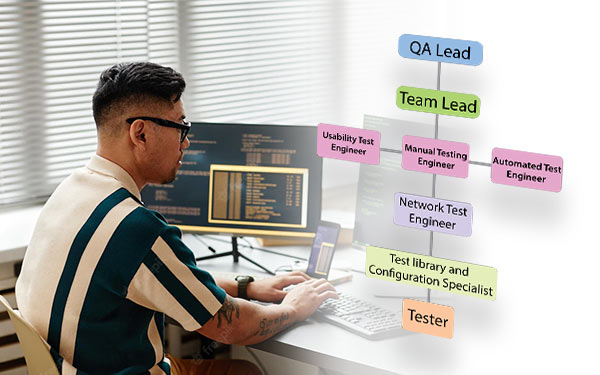Testing ensures that a product works as expected by accurately representing how it will work for users. Test automation may be used to test individual components of a system or entire systems. Test automation can also be used in regression testing, where it can help improve quality and reduce costs by automating repetitive tasks. Software testers perform various activities in order to identify and fix issues with the software.
These activities include
- Testing the software by manually executing it
- Analyzing test cases
- Testing for regressions
- Running automated tests and more.
Software Testing can be classified as black-box testing and white-box testing. Black-box testing is about analyzing the internal structure of software and looking for defects in its design (e.g., inadequate data structures, and lack of error handling). White-box testing is about analyzing the "behavior" of software (e.g., checking if it obeys certain rules). Testing can be done manually or automatically. There are many Manual Testing Courses available for you to master testing. The automated testing tools are not just limited to web applications but also to mobile and desktop apps. They include a set of pre-written test cases and run on every build of the application or software.
The automated testing tools help in reducing the time needed for manual testing by creating test scenarios with predefined inputs and outputs. It also helps track the application's performance over time by generating reports on performance metrics such as response time, throughput, failure rate, etc. Software Testing is important to ensure that the quality of the product meets user requirements and expectations. It helps reduce the risk of errors, which can cause severe problems for customers and businesses. It also helps improve software quality by identifying bugs or issues before they are released to end users.
Why Has Testing Become So Popular?
Testing is a process that helps us find the flaws in our code. It's a way to ensure that the software we develop is not only bug-free but also secure. Testing has become a popular topic in the software industry. Of course, it has been around for a long time, but it has only recently become so popular. There are many reasons for this, one of which is the rise of agile development methods. It became popular because it offers flexibility to companies as well as scalability. Software testers can work with various teams at different levels and use automation tools that help them scale their work efficiently. The importance of Software Testing can be seen in the fact that it is an essential part of every software product. With the growing number of software products, this profession has taken on greater importance and is a highly sought-after skill.

There are many Automation Testing Courses available that teach every aspect of automation testing in-depth! Enroll in one of them and start your career in this field!
What is the role of a Software Tester?
Software testers are the people who test software to make sure that it works as expected. They typically work in programming and development departments or a testing company. Software testers are responsible for ensuring that the software's quality is up to standard, and they also do a lot of manual testing. They also help find bugs, errors, and issues with the software before it's released to the public.
Responsibilities of a Software Tester include:
- Identify defects
- Provide solutions for those defects
- Manage risks associated with software release
- Support product development by providing feedback about product quality The Software Tester is responsible for creating test cases based on specifications provided by the development team.
The Software Tester makes these test cases to identify bugs or errors in the software. The Software Tester then works with developers to find solutions for these issues before releasing a product for public use. In addition, Software Testers are responsible for assisting in quality assurance during the development process. They are also responsible for ensuring that all aspects of a project are completed according to specifications and release schedules. Software Testing is a profession that is rapidly growing in demand, and salaries are following suit. Salaries for software testers vary depending on location, experience, skillset, and company size. The annual pay for software testers in India ranges from ₹ 1.5 lakhs to ₹ 8.5 lakhs.
Skills of a Software Testing Expert
Software Testing is an essential skill for any software engineer or developer. It is a process of evaluating the software to find and fix bugs and ensure that the quality of the product meets requirements. Software testers often have to deal with the software code and build test cases specific to their client's needs. They also need to know how to make sense of data collected from tests and analyze them in terms of quality, efficiency, performance, etc.
Skills of an Expert involve:
- Analysing Code for Defects
- Debugging
- Automation Testing
- Manual Testing
How to Start a Career in Software Testing?
Software Testing is a profession that is seeing a rise in demand. It is one of the fastest-growing careers worldwide. It offers a variety of career opportunities for people with diverse skill sets and interests. The most important thing to remember when starting a career is that it requires dedication and hard work. It is also important to keep up-to-date on the latest developments. It is a booming industry that is expected to expand in the coming years. This means that there will always be a demand for qualified testers, and there are many ways to get into this field. If you want to start your career as a tester, then you need to understand what it entails and how the process works. The first step, however, is getting an appropriate education. If you want to get into it, Software Testing Tutorial at TOPS Technologies is a great place to start. It gives you the knowledge & skills to take your career to the next level of success. If you live in Surat you can take the Software Testing Course in Surat that will provide you with the confidence to test software and write better test cases.
What is Software Testing Career Scope?
The career scope here is vast. Software testers are responsible for testing software to ensure that it functions as intended and to check that it meets the quality standards set by the business. They can also test software in various environments, including mobile applications, web browsers, and hardware devices. They work with developers to ensure their code functions as intended before releasing it into production. They might also be part of an IT team responsible for maintaining systems and infrastructure. Software testers might also work on projects related to quality assurance or release management to help companies meet their targets and deadlines. It is a lucrative career with a lot of scope. There are many job roles, and you can work on different projects. The range of activities covered by this profession includes things like Requirement Analysis, Defect Detection and Correction, Test Case Design, Test Execution, and Analysis, Defect Tracking, and Defect Management.
Jobs are available worldwide, which include roles as: -
Software Tester:
A software tester is responsible for identifying, investigating, and reporting software defects. They must be able to test the software in different environments and with other users. Software testers must be aware of all the risks involved in testing the product and know how to minimize them.
Software Developer:
Software developers are responsible for designing, developing, and maintaining software applications. A software developer is not just a programmer. They are also responsible for the design of their product, which includes thinking about how people will interact with the product and ensuring that it's user-friendly.
QA Engineer:
QA Engineers are responsible for testing software and ensuring product quality. They ensure that the product functions properly and contains no bugs or errors. QA engineers are also responsible for managing user bug reports, tracking bugs, and fixing them on time.
Test Automation Engineer:
The Test Automation Engineer is primarily responsible for designing, implementing, and maintaining a test automation solution that meets business requirements through the effective use of test automation tools, test cases, and scripts. Enroll in an Automation Testing Course in Ahmedabad to get started in this field and make a bright career!
Test Manager:
Test managers are responsible for the quality of the product. They ensure that a project is delivered on time and with high-quality standards. Test managers play a crucial role in ensuring that the product meets its target quality standards and also support their team by understanding their needs and requirements.
Languages You Must Learn To Become a Successful Software Tester
The most commonly used programming languages for Software Testing are Ruby, Python, Java, and C. These programming languages are used because of their flexibility and portability. These languages are also easier to learn than other programming languages. The reason why these four programming languages are the most commonly used is that they have a large number of tools that can be used with them, which helps in testing the software. Ruby is the fastest-growing programming language in the world. It is a popular choice for web development and can be used to program apps on mobile platforms. Python is an easy-to-learn programming language with a syntax that is similar to that of Ruby or Perl. It has been widely used in data science and machine learning projects. Java is a popular choice among developers because it has many libraries available, making it easier to build robust applications. Finally, C is one of the most common computer languages which are used for developing systems software like operating systems, compilers, interpreters, debuggers, and more.
How to Become a Certified Software Tester?
The career is rewarding because it offers many potential opportunities for growth. Software testers are called upon to provide input on the quality of the product and make recommendations on how to improve it. Becoming a certified software tester is not easy, but with TOPS Technologies, you can get your Software Testing Certification in just twelve weeks. The Software Testing Course is designed to provide a comprehensive understanding of Software Testing basics and advanced concepts.

Software Testing Course Curriculum Outline
The course is designed in such a way that it covers all major topics related to types of Software Testing, including unit and functional testing, regression testing, design patterns, performance tuning, and code review. Students are given the opportunity to learn how to become professional software testers and develop their skill sets in this field. You must know what topics are covered before enrolling on the course so that you can make an informed decision on whether it will benefit your career. The Software Testing course syllabus will help you better understand the various topics taught at TOPS. Download the course curriculum outline for more information.
Enroll and Start Learning Now!
Software Testing: Information Repository
FAQs
What Is Software Testing?
Software Testing is the process of analyzing computer software to identify defects and failures. Testing can be done manually or using automated tools, such as unit testing, integration testing, functional testing, and system testing. In addition to finding software bugs, testers can find security vulnerabilities in the code. Software testers are often subject matter experts who use their knowledge of a particular application domain to test it. They may also work as members of development teams or in other roles related to software development and delivery. It is a crucial process of software development that ensures the quality of the final product.
Some of the benefits include:
- Allowing companies to ship products faster and more efficiently
- Ensuring that the customer has a better experience with their products
- Assuring customers that their data is safe and secure
What Is Testing in Software Testing?
Testing is a process that helps identify defects in software. It involves the execution of tests, checking the results, and making changes to fix the defects found. Test automation is a key part and it helps automate repetitive tasks so testers can focus on more challenging tasks and ensure all aspects of the application are tested thoroughly. Testing involves checking for software errors or bugs, whether done manually or through automated testing tools such as Selenium WebDriver and Appium. This is done by executing a program with a series of test cases that are designed to uncover software bugs. Enroll in a Selenium Course and master every aspect of Selenium testing!
Testing has many purposes, such as:
- Assuring the quality of software before it goes into production
- Identifying and resolving issues before they become problems or costly
- Meeting deadlines and budget constraints
What Are the Different Types of Testing in Software Testing?
Software Testing is necessary to ensure that software products are working as intended before they are released to the user base. It can be done in many ways, but one way to do it effectively is by using different types of testing approaches: black box, white box, and grey box testing. Black Box Testing is conducted by simulating the application with the help of a software model. This type of testing is often used to test an application's functionality, performance, and security. White Box Testing is a type that tests the internal structure of an application. It only tests how an application works internally without considering its external interface or user experience. The main goal of this kind of testing is to ensure that there are no errors in the code and it's working properly as intended by developers. Grey-box testing is a method that combines white-box and black-box techniques to test a program's internal and external aspects.
What Are the Different Levels of Testing in Software Testing?
There are various levels of testing, including unit testing, integration testing, system testing, and acceptance testing.
Unit tests are the most basic form of software tests. These tests focus on the smallest units of code - functions and methods. They are usually written by developers and run in a separate environment like debuggers or IDE.
Integration tests check how different parts of the application work together to provide functionality for users. These tests can be automated using tools like Selenium or WebDriver.
System testings focus on how well an application works as a whole from end to end without any manual intervention from the testers themselves.
Acceptance Tests verify that an application meets the needs of its intended audience and are typically conducted by an audience of those who will be using the application.
What Is a Bug in Software Testing?
A bug in Software Testing refers to any defect or error in the software's design, implementation, or behavior. Bugs are often caused by programming errors or omissions in quality assurance processes. A bug can also be a flaw, deficiency, problem, or mistake in something's design or performance. Software testers are responsible for finding these bugs and use various tools like unit tests, automated testing, and manual testing. Types of bugs:
1) Logic Errors - These are the simplest type of bug that is usually caused by an incorrect assumption or a missing requirement. These types of bugs are typically easy to fix because they have a straightforward solution.
2) Performance Issues - Performance issues refer to any performance problem arising from an application's performance or user interface (UI). These problems can be caused by anything from an inefficient algorithm to bad code design or poorly designed UI elements.
3) Security Vulnerabilities - Security vulnerabilities refer to any security-related issue arising from an application's code or user interface (UI). These problems can be caused by anything from a lack of input validation to the usage of insecure cryptographic protocols. The bug life cycle in Software Testing starts when the developer releases the software to production. After that, it is up to the QA team and software testers to find and fix them. The most common phases in a bug life cycle are discovery, analysis, acceptance testing, regression testing, deployment, and finally, fixing.
What Is the Difference Between Verification and Validation in Software Testing?
The term verification is a process of ensuring that the software meets its requirements. Manual testers usually perform verification, and it can be time-consuming. Validation is a process of ensuring that the software meets its needs, and it can be done automatically by computer programs. Validation helps reduce cost, time, and effort. When software testers use verification, they are simply checking whether or not a given program works as expected. On the other hand, when software testers use validation, they try to ensure that the program works as intended and meets its requirements.
What are some specific examples of Software Testing principles?
Software Testing principles are the guidelines that should be followed when conducting Software Testing. These principles are used to help ensure that the quality of the software is at a high level and is free from bugs. The Software Testing principles are based on the fact that every test case should be designed to verify one particular requirement or statement. Therefore, the requirements are usually expressed as a high-level specification describing what is to be tested. There are many different approaches and methodologies used, but they all share some common principles, such as:
- Testing in context
- Testing where it matters
- Test often, testing early, testing often
- Testing with a hypothesis
- Using automation for repeatable tasks
What Is Test Plan in Software Testing?
There are many Software Testing tools available on the market. However, not all of them are suitable for every type of project. Some Software Testing tools might be more effective than others in certain situations. A test plan is an essential part of the process, and it must be documented to gain the full benefits of automation. The test plan is a document that provides information about all the tests that will be performed on a software product, what they are called, and what they will do. It also includes information about any other activities required to conduct these tests. A test plan helps us identify what needs to be tested, what tests should be executed and how they should be executed. It also helps us identify any risks that might arise from the test execution process, which can lead to a failed project or at least delayed delivery time.
What Is the Best Way to Prepare for Software Testing Interview Questions?
The Software Testing Course at TOPS Technologies is designed to help you prepare for your Software Testing interview questions and realistically test your skills.
TOPS Technologies offers a variety of features, including:
- A comprehensive course on answering the most common Software Testing interview questions, including soft skills and technical aspects.
- A database of over 100 practice questions designed to simulate real-life scenarios.
- Realistic mock interviews with customized mock interviewer responses.
- Interview preparation tips and tricks from top professionals in the field.
The TOPS Technologies course is designed to teach students about the latest and greatest technologies. It will cover topics like web development, cyber security, programming languages, and more. If you want to be successful in the IT field, it's important that you have a good understanding of all the latest technologies. The training course is perfect for anyone who needs to be ready for a career in the IT field. Learn android programming from our expert trainers and gain skills that are in high demand! The training course is perfect for anyone who needs to be ready for a career in the IT field. Learn python courses from our Python Training Institute.
We provide the best Software Testing Course in Surat, Vadodara, Ahmedabad, Rajkot, and Nagpur with live projects and 100% placement assistance.
Author Bio:
Niral Modi works as a Chief Executive Officer at TOPS Technologies Pvt, which is an Education company with an estimated 303 employees; and was founded in 2008. They are part of the Executive team within the C-Suite Department, and their management level is C-Level. Niral is currently based in Chicago, United States.
TOPS Technologies provides software testing training in Gandhinagar, offering Software Training, Hardware Training Classes, Graphic Designing & Web Design Training through Live Project Training. Having tie-ups with 3000+ IT software development companies, we provide a 100% Job Guarantee in Software Development Courses. We are known for our training courses in PHP, python, Java, Android & iOS, AspdotNet, C & C++, Angular Courses, IoT, Software Testing Course, CCNA, Cloud Computing, Ethical Hacking, Hardware Networking, Cyber Security Training, basic programming courses for beginners, Digital Marketing, and SEO. We also teach Laravel, Nodejs, Unity 3D Game Development, Machine Learning with Python, Data Science, and Linux server training!" You can Check out our YouTube channel for more information on any course, such as software testing tutorials, graphic design, and web design, among others








